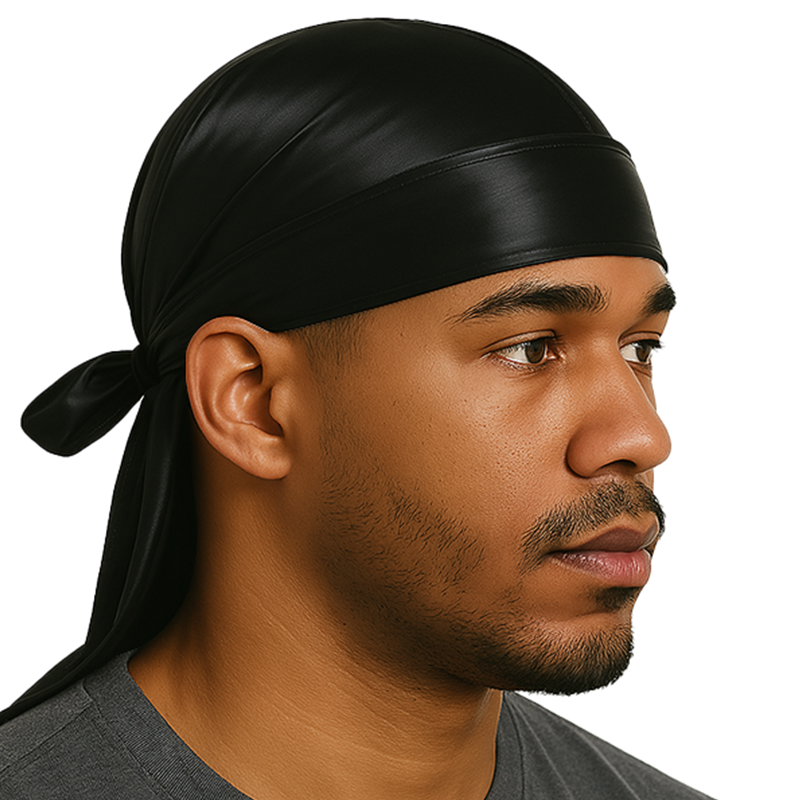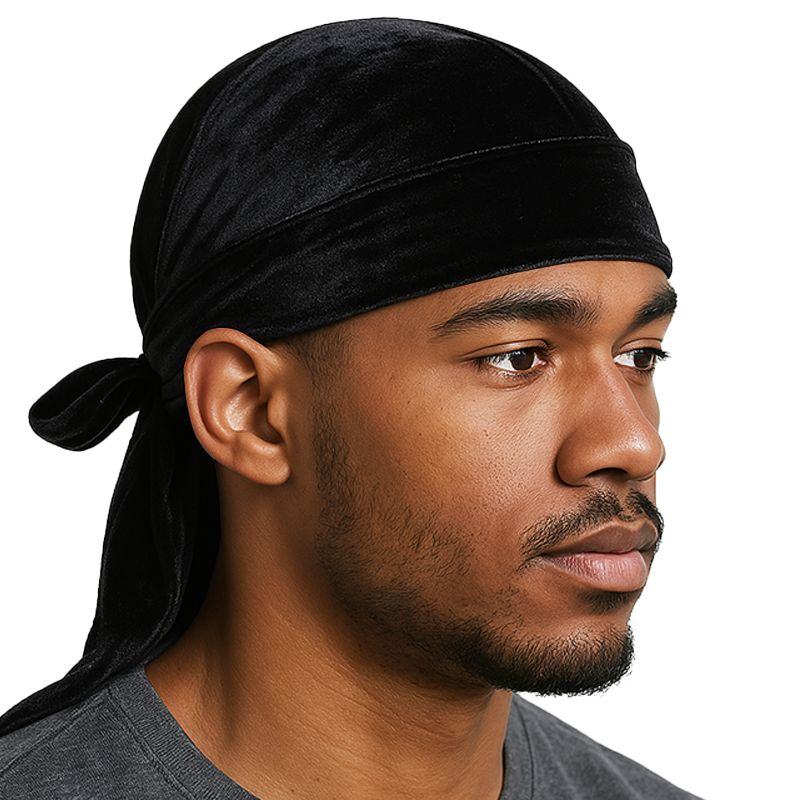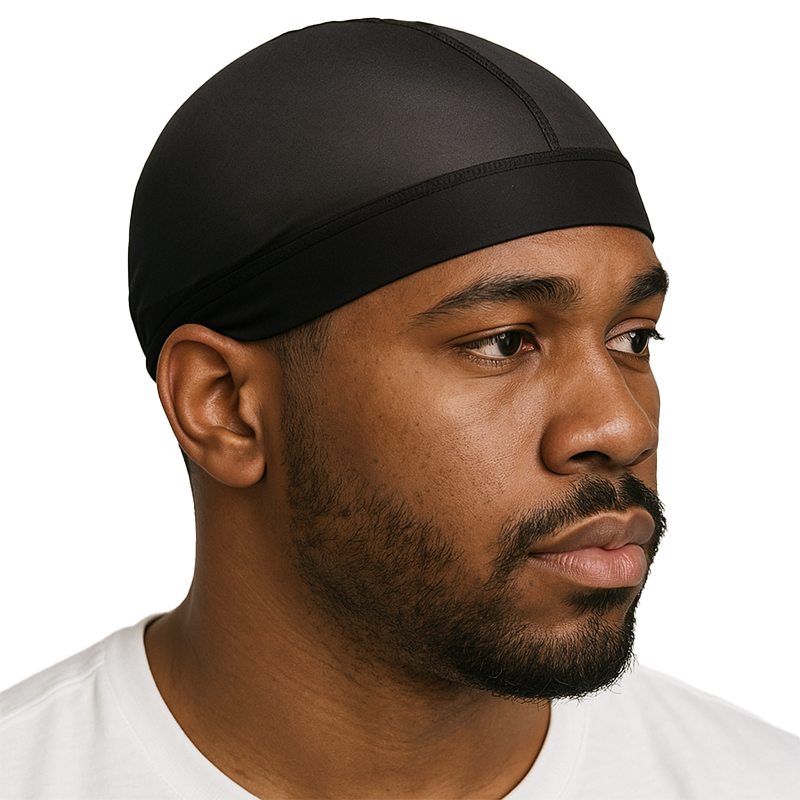Durags have been a popular accessory for decades, particularly among African American men. They are typically worn to protect hair from damage, help maintain hairstyles, and promote hair growth. While putting on a durag may seem straightforward, there are certain steps that need to be followed to ensure that it is worn correctly and effectively.
Understanding Durags Before putting on a durag, it is important to understand what it is and how it works. A durag is a head covering made from a stretchy material such as spandex or polyester. It is designed to fit snugly over the head, covering the hairline and ears. Durags come in a variety of colours and patterns, and can be worn on their own or under a hat.
Preparing to Tie a Durag To put on a durag, it is important to first prepare your hair. This typically involves brushing or combing your hair to remove any tangles or knots. Depending on your hair type and desired style, you may also want to apply a moisturizer or hair oil to keep your hair healthy and hydrated. Once your hair is prepared, you can begin tying the durag.
Key Takeaways
- Durags are a popular accessory among African American men for protecting hair and promoting hair growth.
- Before tying a durag, it is important to prepare your hair by brushing or combing it and applying any necessary hair products.
- To tie a durag, start by placing it at the back of your head and tying it tightly at the front, then adjusting it as needed.
Understanding Durags
History and Purpose
Durags, also known as do-rags or wave caps, have been around for decades. They were originally worn by African-American men to help maintain their hairstyles, particularly waves or "360s". Over time, they became a fashion statement and were worn by people of all races and genders.
The primary purpose of a durag is to keep hair in place and prevent frizz. They are often worn at night to maintain hairstyles while sleeping. Durags can also be worn during the day to keep hair neat and tidy, or to create waves in straight hair.
Material Considerations
When choosing a durag, it is important to consider the material it is made from. Some materials are better suited for certain hairstyles or hair types. For example, silk durags are often recommended for people with curly or frizzy hair, as they help prevent frizz and breakage.
Other factors to consider when choosing a durag include the size and fit. It is important to choose a durag that fits snugly but is not too tight, as this can cause discomfort and even damage to the hair.
Overall, durags can be a useful tool for maintaining hairstyles and keeping hair neat and tidy. By understanding the different types and materials available, individuals can choose the best durag for their specific needs.
Preparing to Tie a Durag
Choosing the Right Durag
Before tying a durag, it is important to choose the right one. Durags come in different materials, sizes, and colors. The material of the durag is important because it affects how well it stays on the head and how comfortable it feels. Common materials include silk, velvet, and polyester. Silk is the most popular material because it is comfortable and helps to retain moisture in the hair. Velvet and polyester are also good options, but they may not be as comfortable as silk.
The size of the durag is also important. It should fit snugly on the head without being too tight or too loose. A durag that is too tight can cause headaches, while one that is too loose can fall off easily. To determine the right size, measure the circumference of the head and choose a durag that matches the measurement.
Lastly, choose a color that complements the outfit or personal style. Durags come in a variety of colors, from basic black and white to bright and bold colors.
Hair Preparation
Before putting on a durag, it is important to prepare the hair. Start by brushing or combing the hair to remove any tangles. If the hair is long, tie it back into a ponytail or bun to prevent it from getting in the way. For those with short hair, ensure that the hair is evenly distributed around the head.
Next, apply a small amount of hair product, such as a leave-in conditioner or hair oil, to the hair. This will help to keep the hair moisturized and prevent breakage. Avoid using too much product, as this can make the hair greasy and weigh it down.
Once the hair is prepared, place the durag on the head with the seam at the back. Pull the flap down over the forehead and adjust the durag so that it covers the hairline. Use the ties to secure the durag in place, making sure that it is snug but not too tight.
Tying the Durag
When it comes to tying a durag, there are a few key steps to follow to ensure a secure and comfortable fit. Here are the steps to tying a durag:
Positioning the Durag
Before tying the durag, it's important to position it correctly on the head. The center seam of the durag should be aligned with the center of the forehead, with the tails hanging down the back of the head.
Securing the Front Knot
To create the front knot, take the two tails of the durag and tie them together at the center of the forehead. Make sure the knot is tight enough to hold the durag in place, but not so tight that it causes discomfort.
Wrapping the Tails
After tying the front knot, take the tails of the durag and wrap them around the head, making sure to cover the entire head. Be sure to keep the durag tight as you wrap the tails around the head.
Final Adjustments
Once the durag is wrapped around the head, make any necessary adjustments to ensure a comfortable and secure fit. This may include adjusting the tightness of the front knot or adjusting the position of the durag on the head.
Overall, with these steps, anyone can easily tie a durag for a comfortable and secure fit.
Durag Wearing Tips
Comfort and Fit
When putting on a durag, it is essential to ensure that it fits comfortably and securely on the head. A loose-fitting durag can easily slip off and cause discomfort, while a tight-fitting one can cause headaches and leave marks on the forehead.
To get the perfect fit, start by placing the durag on the forehead and pulling it back towards the nape of the neck. Then, tie the straps at the back of the head, making sure they are not too tight or too loose. Adjust the durag accordingly to ensure it is snug but not constricting.
It is also recommended to wear a durag made of breathable material such as silk or satin to prevent sweating and discomfort, especially during hot weather.
Maintaining the Durag
To keep the durag in good condition and prolong its lifespan, it is important to maintain it properly. Here are some tips:
- Hand wash the durag with mild detergent and cold water to avoid damaging the fabric.
- Do not wring or twist the durag when washing or drying as this can cause it to lose its shape.
- Hang the durag to air dry or lay it flat on a towel to absorb excess water.
- Avoid exposing the durag to direct sunlight or heat as this can cause fading and shrinkage.
By following these tips, one can ensure a comfortable and long-lasting durag experience.
Common Mistakes to Avoid
When putting on a durag, there are a few common mistakes that people make. By avoiding these mistakes, you can ensure that your durag stays in place and does its job properly.
Not Adjusting the Straps Properly
One of the most common mistakes people make when putting on a durag is not adjusting the straps properly. If the straps are too loose, the durag will not stay in place and will slip off during the night. If the straps are too tight, the durag can cause discomfort and even headaches. It is important to adjust the straps so that they are snug but not too tight.
Using the Wrong Material
Another common mistake is using the wrong material for your durag. Durags come in a variety of materials, including silk, satin, and polyester. Silk and satin are the most popular materials because they are soft and comfortable. Polyester is a cheaper option but can be uncomfortable and cause irritation. It is important to choose a material that is comfortable and suits your needs.
Not Brushing Hair Before Putting on Durag
Before putting on a durag, it is important to brush your hair thoroughly. Not doing so can cause tangles and knots, which can be difficult to remove. Brushing your hair will also help to distribute natural oils throughout your hair, which can help to keep it healthy and shiny.
Wearing the Durag Too Tight
Wearing a durag too tight can cause discomfort and even headaches. It is important to adjust the straps so that they are snug but not too tight. If you feel any discomfort, loosen the straps slightly until you find a comfortable fit.
By avoiding these common mistakes, you can ensure that your durag stays in place and does its job properly. Remember to adjust the straps properly, choose the right material, brush your hair before putting on the durag, and wear the durag snug but not too tight.
Cleaning and Maintenance
Washing Your Durag
Keeping your durag clean is essential to maintain its quality and prolong its lifespan. It is recommended to wash your durag every two weeks or as needed, depending on how often you wear it.
To wash your durag, start by filling a sink or basin with lukewarm water and a mild detergent. Gently swirl the durag in the water, making sure to focus on any areas with stains or dirt buildup. Avoid using hot water, as this can damage the fabric and cause shrinkage.
After washing, rinse the durag thoroughly with cool water to remove any soap residue. Do not wring or twist the durag, as this can damage the fabric and alter its shape. Instead, gently squeeze out excess water and lay the durag flat on a towel to air dry.
Drying and Storage
Once you have washed your durag, it is important to dry it properly to avoid damage or mildew buildup. Do not use a dryer or hang the durag in direct sunlight, as this can cause shrinkage and fading. Instead, lay the durag flat on a clean towel and allow it to air dry naturally.
Once the durag is completely dry, store it in a clean, dry place. Avoid folding or creasing the durag, as this can cause permanent damage to the fabric. Instead, roll the durag up and store it in a drawer or on a shelf.
By following these simple cleaning and maintenance tips, you can ensure that your durag stays in top condition and lasts for many wears to come.














